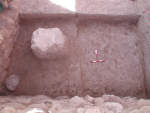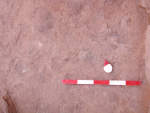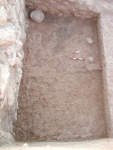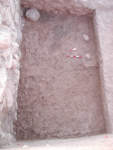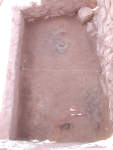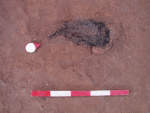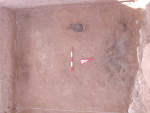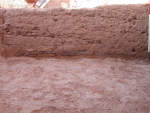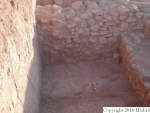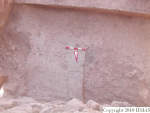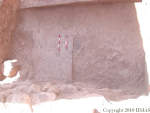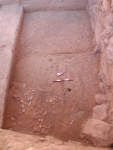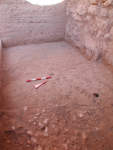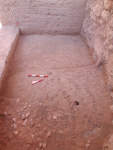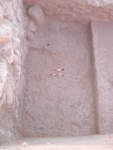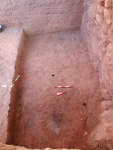1. OVERVIEW
| Roster | Date | Author | Record |
|---|---|---|---|
| Best image | 2014-10-24 | cJC |  [Input: YX24CJC.j] [Input: YX24CJC.j] |
2. IDENTIFICATION
Labeling
| Roster | Date | Author | Record |
|---|---|---|---|
| Notes on labeling | 2007-07-13 | pC | k101 is the pottery column in k13, made in season 2005. in season 2004 probably was the intention do create a new locus k101 for k84 and k85, but because the excavation in k84-k85 during season 2004 was not continued, locus k101 was never created. k101 remains the pottery column in k13 [Input: S205PC.j] |
Designation
| Roster | Date | Author | Record |
|---|---|---|---|
| Description (summary) | 2005-08-02 | aL | k101 is the pottery witness column located in the NW corner of k13; It is a square of 2x2 m; its corners correspond to relays r447, r448, r449, and r450. [Input: P802AL.j] |
| 2005-08-02 | mH | This 2 x 2 locus was separated from the northwestern corner of k13 abutting the oval f128 and the western section of J02. The purpose of the column is to define an area the pottery of which mKB can analyze reasonably quickly. This analysis will help us determine where we are in terms of time period. [Input: P802MH.j] |
3. STRATIGRAPHY
Recovery/Assignment
| Roster | Date | Author | Record |
|---|---|---|---|
| Daily notes about recovery of elements | 2005-08-02 | mH | We excavated one q lot q366 with a big pick. [Input: P802MH.j] |
| 2005-08-03 | mH | We started by remocing the pseudobaulk between k13 and k101. We continued going down with the pick big q371, but starting from q374 we continued with a small pick in order to see whether we would recover more pottery and other finds than with the big pick. aL and pC practiced small picking here during the last few ours of the day. Their q-lot no. was q376. [Input: P803MH.j] | |
| 2005-08-13 | mH | After the elevator and the plastic was removed and the area had been cleaned, we removed the pseudobaulk (f165 q438) we had left in between k13 and k101. We also decided to simplify our definition of this locus. Previously this locus had been defined by relays r447, r448, r449, and r450, which left an approximatly 10-20 cm area between the southern edge of k101 and the southern edge of k13. From today onwards, k101 is defined by r450, r488, r489, and m3965. This definition eliminates the small sliver I mentioned earlier and makes this and k13 easier to excavate and to keep track of. We excavated with a big pick and sifted the soil (sift mesh approximately 1.7cm). All pottery bags marked with a blue ribbom. The first q-lot (q440) contaminated by elevator use and should not be used for dating purposes. There is also a problem with the depth of this q-lot. Other q-lots were q442, q445, q446. The last is only the eastern half of the unit. While excavatin q-lot q442, we found a beautiful bead (i7). [Input: P813MH2.j] | |
| 2005-08-14 | mH | We started by removing soil in the northern half of the unit that was left higher at the end of the day yesterday. The pottery noticed and baged below is contained in q449 whereas the pottery recovered by the sifter is contained in q454. We removed the column under the tent pole in the NW corner of the area (f172 q456). We did not mark this pottery with the blue ribbon used for pottery coming from the column, since it contains material from several features. After the last pick run we noticed that the soil had changed characteristics. It was now browner, it contained pebbles, animal bone, pottery sherds etc. We labeled this feature as f174. This corresponds to the feature f171 in k13. The first q-lot excavated in this feature was q458, the corresponding q-lot at the top was q459. While cleaning the surface the unit after pick run contained in q458, we found a seal impression. Because we did not know its exact location, we were unable to make it into an item, but made it a q-item (q458.1) instead. The next pair of q-lots excavated was q463 and q464 of which q464 was by the sifter. [Input: P814MH.j] | |
| 2005-08-15 | mH | We continued with the strategy adopted yesterday: one pick run has one q-lot bag below for the pickman and one above by the sifter. We started with the q-lot pair q482 and q483 with the latter being by the sifter. q482 had laminations near the oval wall (f128). The next pair was q485 and q486 with the latter being by the sifter. Although f174, which we are currently excavating, resembles f171 in k13 in the brown color and in conistency, f174 has had much less ash and charcoal in it. This changed, however, at the end of the day, when we discovered two large concentrations of ash. One was located to the north, near the oval wall, and the other was located to the south. Near the southern ash deposit we also found a white deposit and as of the end of the day we were not sure what that was. In between the ash concetrations we also found a very heavy concentration of charcoal pieces, which we collected as a sample (i10). We start with the excavation of q494 yet, but will begin with it tomorrow morning. The last q-lot excavated (q485) contained very little pottery, which is puzzling. We took pictures of the the ash deposit (v87d and v87e), the white deposit (v87b), and the charcoal deposit (i10). [Input: P815MH.j] | |
| 2005-08-16 | mH | At the start of the morning gB came to take a look at the area formed by k101 and k13 and shown in v87. The elevation this plane in k101 is m3965+39-138 = 88.62 m, i.e. the same elevation where f150 in k4 is currently and where samples q397, q398, and q399 were taken. gB also took a look at the white layer (v87b). He determined that it was vegetable fibers. Their preservation does suggest that this surface was once a horizontal plane. We took a sample of this material (q496.1) and continued excavating. At this point we had been excavating in f174 for about 35 cm so we decided to change the feature (f182), although the brown soil with ash concentrations seemed to continue. After we had dug one pickrun (q494 below and q495 by the sifter), developments in k13 resulted in stopping the excavations there and in k101 temporarily until k14, remaining part of k4 and the north baulk of k5 have been brough to the same level as f150 in k4, f171 (f183) in k13, and f174 (f182) in k101. [Input: P816MH.j] | |
| 2005-08-24 | sC | Today we string the square for the pottery column (k101) in the north-west area of k13 (it has been defined with r709, r710, r712, r713). I checked the area and assigned a new feature number (f228) to the whole square: the top 5-10 cm of this feature are contaminated by the excavation occurred in this area in the previous days (the pottery sherds belonging to the first 5-10cm have been collceted in the qlot581). f228 is the same of f174 and f182. Masom started to dig with the big pick f228. Under only 5 cm form the top of f228 we find a very compact and well defined surface (f234), that continues also in k13 (f231). We took a picture of k101 and k13 (gv102, gv102a) and then we started to remove f234. [Input: P824SC.j] | |
| 2005-08-25 | sC | Before start excavating, I assigned a feature number (f234) to the surface find yesterday under f228 (f228 is the top 5 cm of soil belonging to the last feature exacavated in this area, f182, contaminated by the excavation held in k14 last week). f234 is very well defined in terms of consistence (very compact respect to the accomulation above) and texture (very fine). f234 cover the whole unit and that it extends also in k103 (where is defined as f231), and slopes toward south. In general the north area is generally higer of 7 to 10 cm than the southern one both in k101 and in k103. In k101 there is a difference of 10 cm between the top elevation in the N and the top elevation in the S area of the square. For example, the top elevation of feature f234 in the N area of k101 is m3953 +12 -165, while in the S is m3953 +5 -165. [Input: P825SC.j] | |
| 2005-08-27 | mH | The surface of the unit slopes to the south/southwest. Thus we took the top elevation of f239 q626 from four locations. The north-most elevation is m3953 +12-169 = 88.15, moving south the next elevations are m3953 +4-169 = 88.07, m3953 +5-169 = 88.08, and the southern-most elevation is m3953 +10-175. At the end of the day we took two elevation measurements. The northern-most was m3953 +7-173 = 88.06 and the southern-most was m3953 +3-173 = 88.02. At the end of the day f239 still remained in most of the locus, but following the northern along the oval wall (f128) there was a gray layer we labeled f248. This equals f247 in k103. At the end of the day we decided to combine k101 and k103 as k104 starting tomorrow. [Input: P827MH.j] | |
| 2005-08-27 | mH | We started by excavating in the southwest corner of the locus in f244 (q616). After we had removed that feature, the whole unit was rather uniform. The material (f239) was rather brown with pieces of broken red bricks that were mostly concentrated in the northwest corner of the unit. We removed that with q-lot q626. [Input: P827MH.j] | |
| Strategy (projected or implemented) | 2005-08-02 | mH | Our plan is to first excavate a 10-15 cm big pick run in k101, then do the same in k13 surrounding it and continue working these two loci together like this. We left a small pseudobaulk in between the two loci. This baulk will be removed every 20-30 cm or so and the strings defining the locus will be replaced. The purpose of the baulk is to help us differentiate between the two loci. It is not meant to be left standing. [Input: P802MH.j] |
| Argument | 2005-08-15 | mH | jO suggested that we might be close to a floor surface since this unit and k13 is clearly some sort of a use area. I am puzzled, however, by the fact that we have had very finds from f174 (and from f171 in k13) and even pottery was scarse during the last q-lot of the day (q485). [Input: P815MH.j] |
| 2005-08-25 | sC | We have the same situation also in k103: all the feature exacavated today are characterized by a general difference in hight between the top elevation (aproximately 6 to 10cm) in the north and the south area of the square. Therefore, I decided to take record of both elevations in k101 and k103 for each feature assigned today, in order to have a better idea of the sloping of the accomulations in this area. This may also help in case we need to check the records of the elevations of the qlots; somethimes it has happened, in fact, that we had some difference in the elevation before/after excavating (with the second higer that the first). f234 is rich in pottery (two qlots have been collected: qlot596 and qlot600; for this qlots the top elevation in the N area is m3953 +12 -165 while on the S is m3953 +5 -165.). After two pickrun another surface have been exposed in the NW corner of k101: f239. f239 has a bricky melted consistence and texture and is greyish in colour. At this point, I decided to stop digging in k101 and move Masum in k103: here a different situation have been exposed since we started to dig today. I preferred to move Masum in k103 in order to help Kamiran to dig f235. I prefer to go down at the same elevation in both areas to expose a larger area at the same time and therefore have a better understanding of the stratigraphy in the two squares. [Input: P825SC.j] |
Volumetric Localization
| Roster | Date | Author | Record |
|---|---|---|---|
| Elements within locus | 2007-07-18 | pC | a6 (installation) [Input: S206PC2.j] |
| 2005-08-02 | vVE | f138 (accumulation D) [Input: P912MH.j] | |
| 2005-08-13 | aL | f165 (accumulation D) f166 (accumulation D) [Input: P912MH.j] |
|
| 2005-08-14 | mH | f172 (accumulation D) [Input: P912MH.j] | |
| 2005-08-14 | sC | f174 (accumulation B) [Input: P912MH.j] | |
| 2005-08-16 | sC | f182 (accumulation B) [Input: P912MH.j] | |
| 2005-08-23 | sC | f228 (accumulation A) f234 (floor, type b) f239 (accumulation B) f244 (lens type b) [Input: P913MH.j] |
|
| 2005-08-27 | sC | f248 (accumulation D) [Input: P913MH.j] | |
| 2005-08-13 | mH | i7 (bead) [Input: P913MH4.j] | |
| 2005-08-15 | sC | i10 (charcoal) [Input: P913MH4.j] | |
| 2004-07-24 | mH | q300 (pottery) [Input: O726AP1.j] | |
| 2005-08-03 | vvE | q366 (bones, items, pottery) q371 (items, pottery) q374 (bones, items, pottery) q376 (pottery) [Input: P803AL3.j] |
|
| 2005-08-13 | aL | q438 (pottery) [Input: P813VVE1.j] | |
| 2005-08-13 | sC | q440 (bones, pottery) q442 (pottery) q445 (bones, pottery) q446 (bones, pottery) [Input: P813VVE1.j] |
|
| 2005-08-14 | sc | q449 (bones, pottery) [Input: P909MH.j] | |
| 2005-08-14 | sC | q454 (pottery) [Input: P909MH.j] | |
| 2005-08-14 | mH | q456 (bones, pottery) [Input: P909MH.j] | |
| 2005-08-14 | sC | q458 (bones, items, pottery) q459 (pottery) q463 (bones, pottery) q464 (items, pottery) [Input: P909MH.j] |
|
| 2005-08-15 | vVE | q482 (bones, pottery) q483 (bones, pottery) q485 (bones, pottery) q486 (bones, pottery) [Input: P909MH.j] |
|
| 2005-08-15 | sC | q489 (pottery) q490 (pottery) q494 (bones, items, pottery) [Input: P909MH.j] |
|
| 2005-08-16 | sC | q495 (pottery) [Input: P909MH.j] | |
| 2005-08-24 | sC | q581 (pottery) [Input: P908MH2.j] | |
| 2005-08-24 | fAB | q590 (pottery) [Input: P908MH2.j] | |
| 2005-08-25 | sC | q596 (pottery) q600 (bones, pottery) [Input: P908MH2.j] |
|
| 2005-08-27 | sC | q616 (pottery) q626 (pottery) [Input: P908MH2.j] |
|
| 2005-08-27 | aA | q630 (pottery) [Input: P908MH2.j] | |
| Relays (applicable to elements) | 2005-08-02 | sC | r449 (40010 50234 - 8952 / Relay location: top) [Input: P821MH-R.j] |
| 2005-08-02 | sC | r447 (39951 50366 - 8949 / Relay location: NE corner) [Input: P84VVE2R.j] | |
| 2005-08-02 | sC | r448 (39769 50300 - 8948 / Relay location: WS corner) [Input: P84VVE2R.j] | |
| 2005-08-02 | sC | r449 (40098 50345 - 8952 / Relay location: NW corner) [Input: P84VVE2R.j] | |
| 2005-08-02 | sC | r450 (40030 50195 - 8959 / Relay location: NE corner) [Input: P84VVE2R.j] | |
| 2005-08-13 | sC | r488 (39722 50302 - 8931 / Relay location: top) [Input: P815MH-R.j] | |
| 2005-08-13 | sC | r489 (39948 50378 - 8927 / Relay location: top) [Input: P815MH-R.j] | |
| Extension of locus or q-lot | 2005-08-02 | aL | r447 [Input: P913MH3.j] |
| Length of two sides | 2005-08-02 | aL | 200s [Input: P913MH3.j] |
| 2005-08-02 | aL | 200w [Input: P913MH3.j] |
